Instead of usual sashimi accompaniment 刺し身のけん, I used vinegared "Namasu" diakon 大根なます garnished with ikura salmon roe and octopus. Herring roe 数の子 and marinated salmon were also added. Ankimo was served in a separate plate with orange marmalade-soy sauce.
It was a nice start for New Year's Izakaya feast.
Tuesday, January 5, 2010
New Year's day sashimi assortment 元旦の刺身盛り合わせ
Monday, January 4, 2010
"Tsukune" Chicken patty and mountain yam fritter 鶏のつくねと長芋のフリット
"Stukune" つくね is ground meat (chicken is most common) with binder and seasoning made into a ball or patty. It is one of the most popular "Yakitori" 焼き鳥 item but it can be deep fried, pan fried or boiled. Here I made another popular version of chicken "stukune". As an accompaniment, I also made a "mountain" yam fritter.

The recipe is rather simple. I used pre-ground chicken (1/2 lb), added sauteed finely chopped onion and shiitake mushroom mixture (2-3 tbs), "Yuzu-kosho" 柚子胡椒 (1/2 tsp, commercial kind in a tube) and 1 tsp of potato starch. I made oval flat patties (about 2x4 inch). In a frying pan, add 1-2 tsp of peanut oil and cook each side for 3-4 minutes. I added sake (1tbs), mirin (2 tbs) and soy sauce (2 tbs) and put a lid on. I cooked on low heat for 3-4 minutes, then removed the lid and increased the heat until the liquid became thick and coated the patties. I sprinkled them with Japanese "sanshou" or Sichuan pepper powder.
For mountain yam or "nagaimo" 長芋 fritter (I am not sure what is the right name for this dish, "fritter" is not quite right but piccata is also not right), peel and slice the yam in 1/2 inch thick rounds (I made 4 rounds). Beat one egg and mix in 2 tbs of finely chopped vinegared ginger root (called "Gari", the type you have at the sushi bar) and dried "aonori" powder (1 tsp). Dust each round with popato starch and then coat with egg mixtures. Pan fry in a frying pan with a small amount of vegetable oil (I used light olive oil) for 2-3 minuts on each side until crusts are formed. Eat with salt or soy sauce (I used salt).
I am not sure that the addition of a "Yuzu-kosho" to "tsukune" was a success. It does not have enough fresh "yuzu" flavor to make a big difference. But as far as "tsukune" goes it was more than OK. The mountain yam fritter has a very nice crunchy texture inside and nice eggy crust with ginger and aonori flavors. Very nice texture and flavor contrasts.
For mountain yam or "nagaimo" 長芋 fritter (I am not sure what is the right name for this dish, "fritter" is not quite right but piccata is also not right), peel and slice the yam in 1/2 inch thick rounds (I made 4 rounds). Beat one egg and mix in 2 tbs of finely chopped vinegared ginger root (called "Gari", the type you have at the sushi bar) and dried "aonori" powder (1 tsp). Dust each round with popato starch and then coat with egg mixtures. Pan fry in a frying pan with a small amount of vegetable oil (I used light olive oil) for 2-3 minuts on each side until crusts are formed. Eat with salt or soy sauce (I used salt).
I am not sure that the addition of a "Yuzu-kosho" to "tsukune" was a success. It does not have enough fresh "yuzu" flavor to make a big difference. But as far as "tsukune" goes it was more than OK. The mountain yam fritter has a very nice crunchy texture inside and nice eggy crust with ginger and aonori flavors. Very nice texture and flavor contrasts.
Friday, January 1, 2010
A Happy New Year 2010 謹賀新年
I had to work until 12/31/09. So I did not have time to put together the usual New Year's boxes お節の重箱 but managed to make or buy the usual good luck new year dishes.
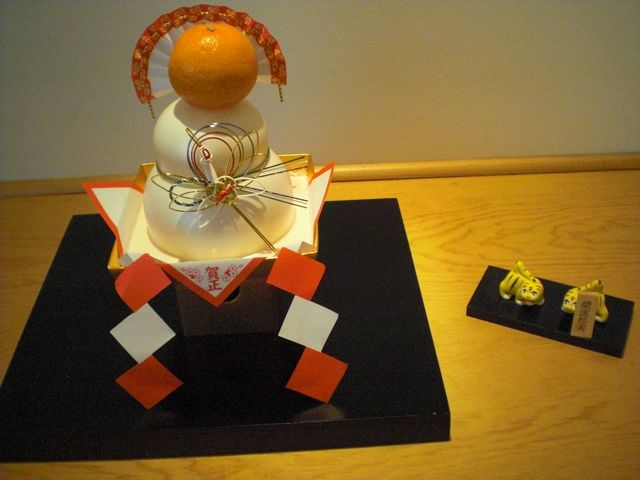
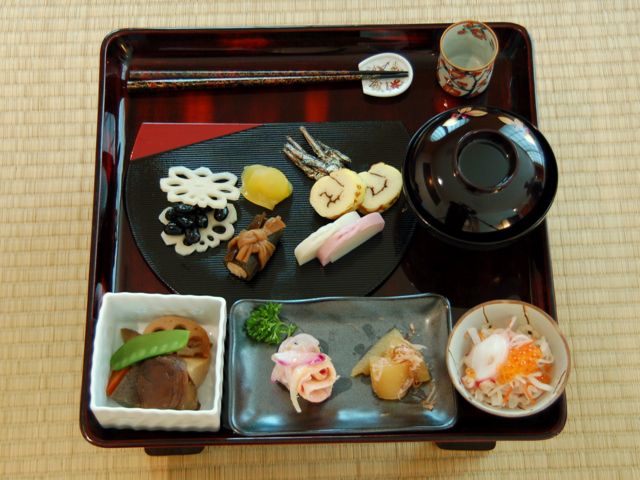
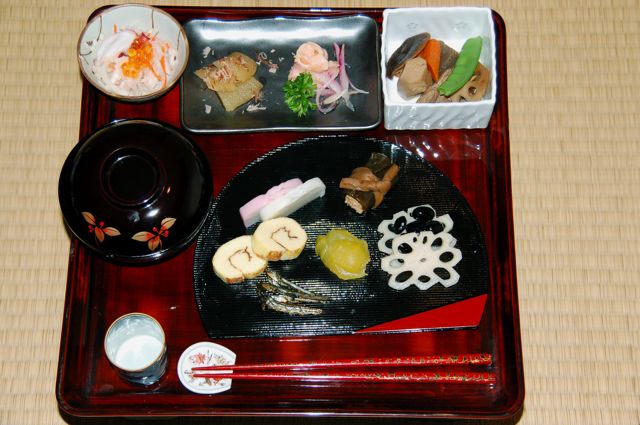
New Year Soup お雑煮
Only unusual thing I do is to put "mochi" 餅 or rice cake in " fried tofu pouch "aburage" 油揚 as per my wife's request. So that the sticky mochi will not dissolve or attached to your teeth and the bowl. In addition to keeping the mochi under control, the combination tastes pretty good.

Assorted appetizers "Kuchitori" お口取り
Small fish ごまめ, red and white fish cakes 紅白かまぼこ, sweet chestnut 栗きんとん and black beans 黒豆 are bought ready made. The rest were home made. Rolled omelet 伊達巻きwas made from eggs and commercial "hanpen" はんぺん a type of white fish cake, lotus root or renkon レンコン was bought already cleaned and boiled but then I made this "flower" cut and vinegared it. For the first time, I also made kelp roll with salmon 鮭の昆布巻き, which, if I say so myself and my wife (who is impartial) also agrees that this was much much better than the commercial product.

Vegetable and chicken stew 筑前煮
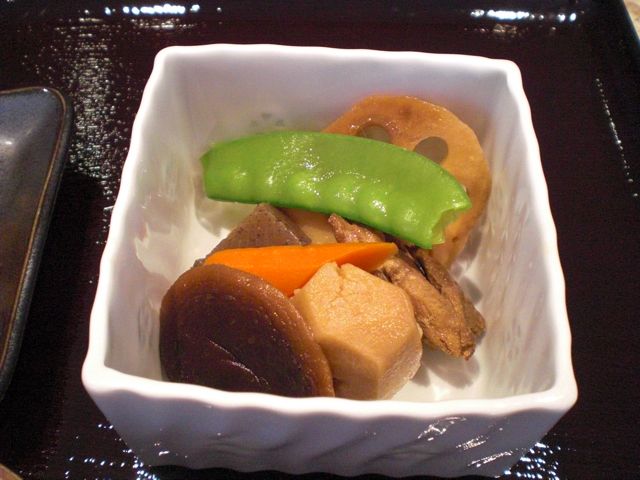
Marinated salmon 鮭のロシア漬け、Herring roe 数の子
This salmon dish is my mother's recipe. She does not remember where she got it. Thinly sliced salmon was layered with onion, lemon slices and marinated in a mixture of sake, rice vinegar and olive oil for at least 3 days. The herring roe was first soaked in weak salt water to remove salt (they are sold preserved by heavily salting) and then marinated in dashi, mirin, and soy sauce mixture for a few days.
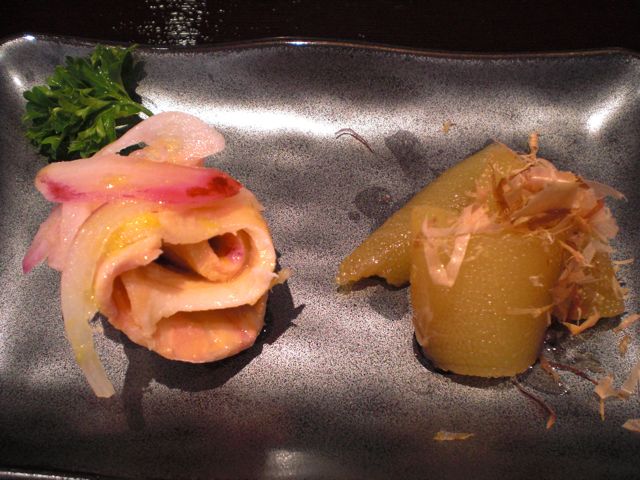
Julienned Daikon "Namasu" in sweet vinegar 大根なます, vinegard octopus 酢蛸,
Salmon roe いくら
For "Namasu", as per my mother's recipe, I do not add water or dashi and we like more assertive vinegar taste. The octopus was bought boiled and frozen and then sliced and vinegared before serving.
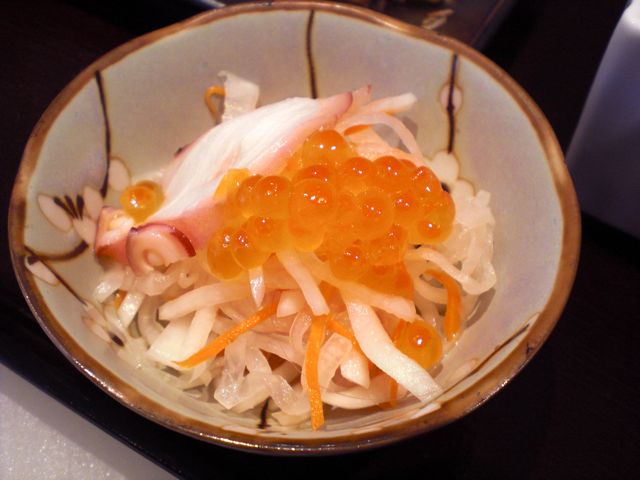
Chicken patty with pine nuts and miso 鶏肉野松風焼き, Scotch egg スコッチエッグ
I used boiled quail eggs rather than hens eggs for my Scotch eggs.
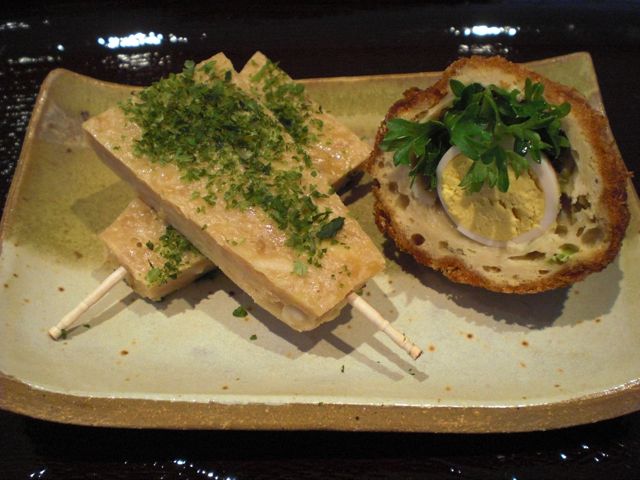
Only unusual thing I do is to put "mochi" 餅 or rice cake in " fried tofu pouch "aburage" 油揚 as per my wife's request. So that the sticky mochi will not dissolve or attached to your teeth and the bowl. In addition to keeping the mochi under control, the combination tastes pretty good.
Assorted appetizers "Kuchitori" お口取り
Small fish ごまめ, red and white fish cakes 紅白かまぼこ, sweet chestnut 栗きんとん and black beans 黒豆 are bought ready made. The rest were home made. Rolled omelet 伊達巻きwas made from eggs and commercial "hanpen" はんぺん a type of white fish cake, lotus root or renkon レンコン was bought already cleaned and boiled but then I made this "flower" cut and vinegared it. For the first time, I also made kelp roll with salmon 鮭の昆布巻き, which, if I say so myself and my wife (who is impartial) also agrees that this was much much better than the commercial product.
Vegetable and chicken stew 筑前煮
Marinated salmon 鮭のロシア漬け、Herring roe 数の子
This salmon dish is my mother's recipe. She does not remember where she got it. Thinly sliced salmon was layered with onion, lemon slices and marinated in a mixture of sake, rice vinegar and olive oil for at least 3 days. The herring roe was first soaked in weak salt water to remove salt (they are sold preserved by heavily salting) and then marinated in dashi, mirin, and soy sauce mixture for a few days.
Julienned Daikon "Namasu" in sweet vinegar 大根なます, vinegard octopus 酢蛸,
Salmon roe いくら
For "Namasu", as per my mother's recipe, I do not add water or dashi and we like more assertive vinegar taste. The octopus was bought boiled and frozen and then sliced and vinegared before serving.
Chicken patty with pine nuts and miso 鶏肉野松風焼き, Scotch egg スコッチエッグ
I used boiled quail eggs rather than hens eggs for my Scotch eggs.
Wednesday, December 30, 2009
Seared Tuna salad 炙り鮪のぬたサラダ
Again, this is a continuation of how to enjoy tuna sashimi in different ways. Mark's book (p80) has a similar more traditional recipe, "Tuna 'Nuta' with Miso Mustard dressing". I make this dish slightly differently. "Nuta" ぬた is a traditional Japanese dish in which raw fish, sea weed, and "wakegi" わけぎ (which is very similar or identical to scallions -green or spring onions- we get in the U.S.) are dressed in sweet miso mustard sauce "karashi sumiso" からし酢みそ. I made some modifications to this traditional recipe and made it into a salad. I used the "tataki" technique for tuna and cooked the scallions over direct gas flame. This way, the tuna attains a nice firm texture and the scallions become very sweet. You could just boil the scallions as suggested in Mark's book. For added texture, I used grilled "abura-age" 油揚げ or deep fried tofu pouch and everything was set on the top of dressed greens (I used baby arugula here but any leafy greens will do). Of course, if you omit the greens, that will also be just fine with sake.

I used 1/3 "saku" 冊 or block of tuna sashimi (previously frozen) for two servings. After thawing, remove any moisture from the surface and salt both sides. To sear the surface, you could use a frying pan with a bit of oil but I used the traditional Japanese method of a direct gas fire (or charcoal fire). I put two metal skewer, fanned out, through the tuna and held it over the flames until all surfaces were white with small light brown patches but the center was still raw. I plunged the tuna into ice water to cool. I then dried with paper towels and cut into bite size pieces.
I selected thick scallions (3-4) rather than thin ones. Holding the green part, I charred the white part of the scallion over the direct flame until the outer skin blackened. I set them aside until they were cool enough to handle (1-2 minutes). I then removed the root end and outer most blackened layer and cut the white and contiguous green parts into 1/2 inch long segments.
I put one abura-age in a toaster oven and toasted it like I would a slice of bread until surface was brown and crispy (I could have used direct flames as well). I cut it into 1/3 inch strips.
To make "nuta" or "sumiso" sauce (I posted this before); this time I used regular white miso (2 tbs), sugar (2 tbs) and mixed in enough rice vinegar to make a saucy consistency. If the sauce is vinegary enough but still too thick, you could add a bit of 'dashi" or sake. I also added 1/3 tsp of prepared hot Japanese mustard. In Mark's book, this sauce was made with the addition of mirin without sugar (mirin is sweet) and less vinegar which makes the sauce less vinegary but I like a more assertive vinegary taste. Dress all the above ingredients except for the greens with this sauce.
For the baby arugula, I simply dressed with a splash of rice vinegar and good quality olive oil, salt and black pepper.
Just place the greens on the bottom of the plate and make a mound of "nuta" on the top. My wife usually does not like scallions in big pieces but this time because of the method of cooking them they were very soft and sweet and she liked it. Abura-age added a nice crunch and everything came together with the smooth miso sauce. Arugula has nice peppery taste which also added to the overall flavor.
To make "nuta" or "sumiso" sauce (I posted this before); this time I used regular white miso (2 tbs), sugar (2 tbs) and mixed in enough rice vinegar to make a saucy consistency. If the sauce is vinegary enough but still too thick, you could add a bit of 'dashi" or sake. I also added 1/3 tsp of prepared hot Japanese mustard. In Mark's book, this sauce was made with the addition of mirin without sugar (mirin is sweet) and less vinegar which makes the sauce less vinegary but I like a more assertive vinegary taste. Dress all the above ingredients except for the greens with this sauce.
For the baby arugula, I simply dressed with a splash of rice vinegar and good quality olive oil, salt and black pepper.
Just place the greens on the bottom of the plate and make a mound of "nuta" on the top. My wife usually does not like scallions in big pieces but this time because of the method of cooking them they were very soft and sweet and she liked it. Abura-age added a nice crunch and everything came together with the smooth miso sauce. Arugula has nice peppery taste which also added to the overall flavor.
Monday, December 28, 2009
Tuna tartar with cucumber and grape 鮪のタルタル
If tuna sashimi is in good quality, it is best to eat it simply with wasabi and soy sauce. If you like to have tuna sashimi in different ways or the quality of tuna sashimi is not really good (often in my case), you could make something different. I already posted a few variations on this theme.
This particular night, I made tuna tartar, which is a fairly common Western adaptation of tuna sashimi. Again, this is not a recipe per se, you could make many variations on this theme to your liking. I just chop tuna sashimi in small cubes, mix in finely chopped chives, soy say sauce with wasabi dissolved, a dash of good quality olive oil to your taste. If you like, you could use, chopped perilla and/or scallion, tabasco, sesame oil etc for variations.
To make the taste a bit more interesting, I made a sweet vinegar miso sauce with Japanese mustard "karashi sumiso" からし酢みそ in addition. I used "saikyo" miso 西京味噌, which is sweet to begin with. I used 1 tbs of saikyo miso, 1/3 tsp of prepared hot Japanese mustard (in a tube), 1/2 tsp sugar, and added rice vinegar until a nice smooth saucy consistency is reached. I did this in a Japanese mortar "suribachi" すり鉢 and pestle すりこぎ but you could use a small bowl attachment using a food processor or you could just buy a premade "sumiso" sauce. Taste and adjust the degree of sweetness by adding more sugar.
Saturday, December 26, 2009
Deep fried stuffed Shiitake mushroom 椎茸の肉詰め揚げ
This is a variation from "Deep fried stuffed peppers" (Mark's book p20). This is also a fairly common dish. Actually, one of the reasons I made this dish is (like Pork meat ball nabe dish) to use up the meat stuffing I made for gyoza. Somehow we did not feel like having gyoza repeated for a few days. In any case, the recipe is rather simple.
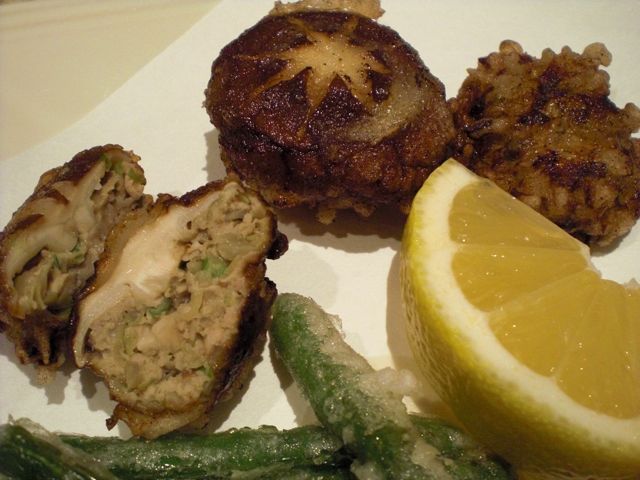
For the meat stuffing, you could use any kind of ground meat such as pork, chicken or even beef or a mixture of beef and pork. Here, since I used gyoza stuffing, it is made of pork, minced cabbage, scallion, ginger, garlic and seasoned with soy sauce, mirin and black pepper. You could use just meat but I prefer to lightly season it, at least with salt and pepper. Since this is a type of tempura, you could eat this with a tempura dipping sauce with grated daikon or graded daikon with red pepper "momijo-oroshi" 紅葉おろし as suggested in the recipe in the Mark's book or with a lemon and salt or just with a lemon juice as we did here because the meat stuffing was seasoned.
I used small fresh mushroom (about 2 inch in diameter). Although it is optional, I made a traditional decorative star-shaped cut on the surface of the shiitake mushroom as seen above. Take the meat stuffing and put it against the gill side of the mushroom and make a small mound. The amount of the stuffing depends on the size of the mushroom, I used 1-2 heaping tsp for each mushroom. I used a rather thin tempura batter. I made about 1/3 cup of the batter with 2tsp each of cake flour and potato starch and added cold water (from the refrigerator dispenser) to make the rather loose batter.
I heated peanut oil or vegetable oil in a pan to 375F (or you could use the more imprecise but easy method of judging the oil temperature as I described before). I used green beans as an accompaniment. I snipped both ends of green beans and coated them with batter. I fried the beans for 1 minute. Then, I coated the stuffed shiitake mushrooms with the batter and fried them meat stuffing side down first and after 2-3 minutes flipped them over and fried another 2 minutes on the mushroom side. I drained the stuffed mushrooms on a pepper towel or on a metal grate.
Small Japanese green peppers called "pea-man" ピーマン required in the recipe in Mark;'s book are difficult to get here in the U.S. and certainly, western green peppers are too thick and too strong in flavor for this dish. Especially since my wife does not like green peppers, shiitake mushroom is better choice for us. Shiitake mushroom has a nice meaty texture and we really like this combination.
Wednesday, December 23, 2009
Pork meat ball Hot Pot 豚ミートボール小鍋仕立て
Hot pot dish called "nabe" 鍋 (which means a "pot") or "nabemono" 鍋物 is a family style homey dish in which a large (usually earthen) pot was placed in the middle of a table on a portable gas or electric cooker. One large pot is shared by the diners and the ingredients are cooked on the table as you eat. This type of communal pot dish is not usual in Izakaya (unless it is a small drinking party held in Izakaya) but a small individual or 2-person nabe is served in Izakaya. Types of nabe are numerous depending on the type of broth and main items you put in it. If the broth is not seasoned, it is usually eaten with a dipping sauce such as "ponzu shoyu" sauce and if the broth is seasoned with either miso or soy sauce, it is eaten as is or with some garnish. After most of the ingredients are consumed a well seasoned savory both is left in a pot. Cooked (leftover) rice or noodles can be added to the broth to make the last starch dish of the meal. It is the best dish to be had in a cold windy night.
We had our first snow of the season in the DC area few days ago and it has been rather cold which prompted me to make this spur-of-the-moment nabe dish using whatever was available. I happened to have extra kelp broth from the night I made the "warm tofu with pork miso sauce". Also, I had stuffing for pork gyoza which I made the night before. So I used these leftovers and made this nabe dish. Instead of a large nabe, I used a small nabe pot usually used to make "nabeyaki Udon" 鍋焼きうどん- a Japanese noodle dish which is cooked and served in a individual pot. I am sure I can post that recipe in near future. The amount is perfect for my wife and I.
For broth, I used kelp broth and seasoned it with sake, mirin, and soy sauce (sorry, all eye-balled and then tasted for further adjustment, no precise amount here). When the broth was hot I used a small ice cream scoop and dropped small balls of the pork mixture for gyoza into the broth. Other ingredients I used were nappa cabbage 白菜 (cut into 2 inch wide pieces), firm tofu 豆腐, daikon 大根 (cut in 1/3 inch-thick, half moon shaped; put diakon in first while the broth is being heated), fresh Shiitake mushrooms 椎茸, and scallion 葱 (cut into 1 inch pieces). I cooked this in the kitchen rather than on the table. This was served in a small bowl with a sprinkling of Japanese 7 flavored pepper powder 七味唐辛子.
After we finished this dish, I took the nabe back to the kitchen and added cooked rice (as usual frozen one, you could defrost first), added thinly cut napa cabbage (soft green part which I reserved). I added a bit more water since the broth has reduced a bit. Cooked 10 minutes in low heat until the rice was cooked and a "porridge' consistency was achieved. I adjusted the seasoning by adding salt or soy sauce (I used salt). I beat one egg and mixed it into the porridge. I put the lid back on and took the pot off the flame. I waited 5 minutes and then served the porridge.
Subscribe to:
Comments (Atom)

